| |
|
|

|
Common Whitetail Plathemis lydia,
sometimes called
"White-tailed Skimmer," was not "officially" added to the Monterey
County
checklist until 2006 despite a long and rich history of studies within
the county. The history of these events is laced with irony and
serendipity,
and they are laid out below.
|
Our story begins at Hastings Natural History
Reservation in upper Carmel
Valley. It was established in October 1937 as a field research station
for the Museum of Vertebrate Zoology at U.C. Berkeley. The habitat here
includes much rolling oak savanna (as shown in the header photo,
above).
Jean M. Linsdale of the Museum staff became the first resident
director.
Natural history studies included a wide variety of subject, although
much
emphasis was placed on birds. Jean's son, Don Linsdale, was interested
in the insects and between 1938-1943 a collection of insects developed,
including 15 species of Odonata (now housed at the Oakland Museum). Plathemis
lydia was not among them. The small stock pond on adjacent land —
to
be called "Blompond" in research papers (see below) — was not yet
present
(it was created ~1970). Since Common Whitetail is primarily a pond
species,
it was likely scarce at Hastings during the Linsdale era.
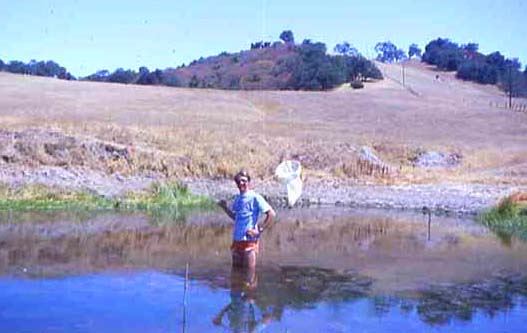
In the mid 1970s, Walt Koenig began longterm studies of Acorn
Woodpeckers
at Hastings NHR. He would acquire his PhD at U.C. Berkeley and become
the
resident research scientist at Hastings for the next two-and-a-half
decades.
In summer 1982, Koenig began to consider the feasibility of research
studies
on dragonflies at "Blompond", a small man-made stock pond located in
oak
savannah on a ranch adjacent to Hastings NHR (that's Walt, right,
standing
in Blompond in summer 1982). In summer 1983, Koenig and grad student
Stephen
Albano undertook a study of the behavior ecology of Common Whitetail on
Blompond , and several other more distant stock ponds. They captured
301
male and 78 females for a study of territoriality and mating success
(Koenig
& Albano 1985). In summer 1984, Koenig, Albano, and research
associates
captured and marked 180 males and 84 females for a studies on lifetime
reproductive success, selection, and site fidelity; 66 of those marked
were transplanted to Blompond for the latter project (Koenig &
Albano
1987a, 1987b). In summer 1985, Koenig captured and marked 48 more males
in a study on territory size and duration. Near the bottom of this
page,
I summarize some of the findings of the Hastings studies.
Below are a couple of photos from the research
project in summer 1984.
There's a shot of Steve Albano at his "look-out" station on the pond,
and
then a group shot of the researchers (Steve, assistants Monica and
Adam,
and Walt on the far right; all photos from 1982-1984 © W.D.
Koenig):
|
|
|
 In
all, Hastings researchers captured 691 Common Whitetails over 3
summers;
marked them with small colored dots (see photo, left), and released
them
to observe their behavior and ecology. It is fair to say that no one in
California knew Common Whitetail better than Walt Koenig and
colleagues. In
all, Hastings researchers captured 691 Common Whitetails over 3
summers;
marked them with small colored dots (see photo, left), and released
them
to observe their behavior and ecology. It is fair to say that no one in
California knew Common Whitetail better than Walt Koenig and
colleagues.
A decade later, in the late 1990s, the first
attempts to create standardized
state and county checklists for Odonata got underway. The criteria
developed
for these lists at first required specimens but eventually included
good
photographs. As Koeing and colleagues took no specimens, nor placed any
photographs in museums or publications, their work was overlooked in
creating
the checklists. Thus it happened that when Rita and I (Don Roberson)
became
interested in odes — 23 years after the first Hastings study —
Common
Whitetail was not included on the Monterey County ode
checklist!
When I first learned this in late July 2006, I was puzzled but, as I
learned
more of the history, the irony of it all grew more and more amusing.
Walt Koenig scanned this photo (left) for me in
November 2006, long
after the "rest of the story" that follows. In retrospect, it is the
first
Monterey County photo of P. lydia. For purposes of our story,
however,
this photograph was not known to exist.
|
| On 9 June 2006, Paul Johnson was among
those participating in the annual
Summer Butterfly Count at Hastings NHR. During the count he observed
several
interesting butterflies, but also found and photographed 3 different
Common
Whitetails in the Hastings vicinity. These were a young male (below
left)
and two females (below, right-hand two). These are apparently the first
photos for MTY, but Paul did not know at the time the species was
"unrecorded"
in the county, so they were not submitted to Odonata
Central for inclusion on the "official" list. |
photos (above) 9
June 2006 Hastings NHR
© P.G. Johnson
photo (below) © W. D. Koenig;
all used with permission
|
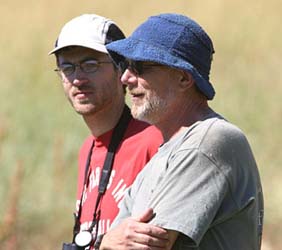 On
1 July 2006, Rita Carratello & I visited Hastings NHR to look at a
roost
of bats in Walt Koenig's garage. Afterwards, sipping ice tea on
Walt's
deck, we happened to mention a budding interest in dragonflies. Walt
told
us about his research on Common Whitetail. He and grad student Justyn
Stahl
(photo right; Walt is in the blue hat) took us over to Blompond to
observe
them. We saw several Common Whitetails and even watched a female
ovipositing
in the pond while the male hovered just above her. We also did not then
know that the species was "unrecorded" in MTY (we did not even know
there
was a Monterey ode checklist at the time), and so we didn't report
these
observations. On
1 July 2006, Rita Carratello & I visited Hastings NHR to look at a
roost
of bats in Walt Koenig's garage. Afterwards, sipping ice tea on
Walt's
deck, we happened to mention a budding interest in dragonflies. Walt
told
us about his research on Common Whitetail. He and grad student Justyn
Stahl
(photo right; Walt is in the blue hat) took us over to Blompond to
observe
them. We saw several Common Whitetails and even watched a female
ovipositing
in the pond while the male hovered just above her. We also did not then
know that the species was "unrecorded" in MTY (we did not even know
there
was a Monterey ode checklist at the time), and so we didn't report
these
observations. |
|
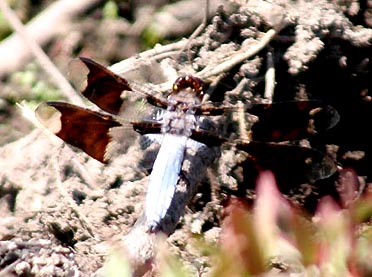 Steve
Rovell did know that Common Whitetail was not on the "official" county
checklist, as he had been odeing in MTY for a couple of years. On 13
July
2006, he found this male (left) on Lake Lagunitas, a small drainage
lake
in rolling grasslands northeast of Salinas and now converted to a stock
pond on private land. Steve reported the find to CalOdes and sent it
through
Odonata Central. This is considered the first "official" record for
Monterey
County. Steve had 2 males and 2 females here. Steve
Rovell did know that Common Whitetail was not on the "official" county
checklist, as he had been odeing in MTY for a couple of years. On 13
July
2006, he found this male (left) on Lake Lagunitas, a small drainage
lake
in rolling grasslands northeast of Salinas and now converted to a stock
pond on private land. Steve reported the find to CalOdes and sent it
through
Odonata Central. This is considered the first "official" record for
Monterey
County. Steve had 2 males and 2 females here.
photo © Steve Rovell,
used with permission
|
|

|
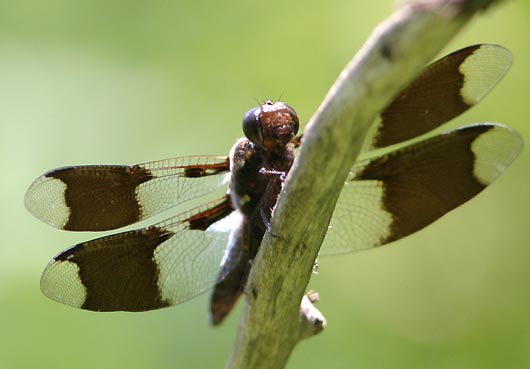 Between
24 July-10 August, I located Common Whitetails at four additional sites
in MTY. Up to 4 males were patrolling territories on Arroyo Seco Lakes
on 24 July 2006 (one of them is shown above). It is interesting that
there
are no prior records from this area, despite the fact that the Arroyo
Seco
Campground area was surveyed for odes on at least these dates: 14 May
1972,
18 Aug 1973, 27 May 1974, 19 July 2004, and 1 July 2005. Perhaps there
are 'good' years and 'bad' years for whitetails in MTY, and the flight
season may be rather short. Indeed, on a return visit on 5 Aug 2006, we
found none. Between
24 July-10 August, I located Common Whitetails at four additional sites
in MTY. Up to 4 males were patrolling territories on Arroyo Seco Lakes
on 24 July 2006 (one of them is shown above). It is interesting that
there
are no prior records from this area, despite the fact that the Arroyo
Seco
Campground area was surveyed for odes on at least these dates: 14 May
1972,
18 Aug 1973, 27 May 1974, 19 July 2004, and 1 July 2005. Perhaps there
are 'good' years and 'bad' years for whitetails in MTY, and the flight
season may be rather short. Indeed, on a return visit on 5 Aug 2006, we
found none.
On 24 July 2006, I found a male (photo left) in
Laguna Grande Park,
Seaside, less than a mile from the coast. All other known locales have
been in the hot, humid interior of the county.
In the studies at Hastings NHR, very few tenerals
emerged from Blompond.
The evidence gathered there suggested that almost all the breeders on
Blompond
came as dispersers from elsewhere (Koenig & Albano 1987). There are
apparently widespread local movements in this species.
|
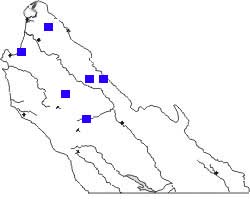 Common
Whitetail is a widespread and familiar species across North America.
Its
absence from the MTY checklist until 2006, as described above, is just
an ironic oversight. The map (right) shows the locales at which it was
observed in 2006. It probably occurs at many interior lakes, tule-lined
ponds, and stock ponds. Common
Whitetail is a widespread and familiar species across North America.
Its
absence from the MTY checklist until 2006, as described above, is just
an ironic oversight. The map (right) shows the locales at which it was
observed in 2006. It probably occurs at many interior lakes, tule-lined
ponds, and stock ponds.
In studies at Hastings NHR in upper Carmel
Valley, breeding activity
was limited to the 11-12 weeks between mid-May and early August (Koenig
& Albano 1985, 1987a, 1987b. The latest MTY record is just 10 Aug
2006
on a stock pond near Soledad (D. Roberson). Elsewhere in California,
flight
dates range from March-October. Its (apparently) short flight season in
MTY is somewhat of a mystery.
|
|
Short Summary of Research Findings
at Hastings NHR
Koenig & Albano (1985) marked and
watched the behavior of 301 males
and 78 females (379 in all) between 15 June-31 July 1983. Males defend
a territory of ~10m long around the perimeter of the pond. Females
comes
to the pond only to mate, and generally arrive about the same time in
early
afternoon. They oviposit immediately after mating by dipping their
abdomen
into the water while the male 'guards' her by hovering overhead (to
avoid
matings by other males). Females leave the pond immediately after
ovipositing
(the eggs develop unattended). Only 79% of males known to be alive
visited
the pond on any particular day. Those that came were divided between
territorial
males and non-territorial 'poachers,' but the same individual could
have
both behaviors on the same day. Males never tolerated males within
their
territories but always chased interlopers. When densities are high,
males
spend only a few hours each day to the pond, so each territory is
defended
by a series of males each day (up to 7 males may defend the same
territory
sequentially). Individual males tended to return to the pond at the
same
time each day, thus "time-sharing" the few available territories.
Koenig & Albano (1987a) marked and
watched the behavior of 180 males
and 84 females (264 in all) in the latter half of the breeding season.
In the study, females came to the pond every 1-5 days they were alive.
The researchers measured lifetime reproductive success and the effects
of selection, presented in substantial and innovative statistical
detail.
In this study, and the preceding and following study, the researchers
essentially
captured the entire summer population on Blompond.
Adults do not overwinter. They live rather short
lives as adults. The 'average' male lived only ~9 days when breeding at
the pond, the 'average' female only 6 days. Day-to-day lifetime
survivorship
is 83-89%. It appears that the longest lived whitetails may be present
for up to 3 weeks.
Koenig & Albano (1987b) watched 122
residents at Blompond (91 male
& 31 female) and 66 transported to Blompond from other ponds (57
male,
9 female) to determine their site fidelity. The study took place
between
19 June-5 Aug 1984. Of the 122 residents from Blompond, 25% were never
seen again (natural mortality, stress of handling, or dispersal). 75%
were
seen again at Blompond but 12% (all males) dispersed to other ponds. Of
those transported to Blompond from elsewhere, 57% remained there but
15%
went back to their original ponds. The longest stay by a transplant at
Blompond was 18 days. Those breeding adults that were being successful
in matings stayed at Blompond. Post-breeding dispersal late in life did
not lead to significant new matings.
Koenig (1990) marked 48 males between 29
June-31 July 1985 and watched
their behavior. Males were at Blompond between 1-24 days; 452 matings
were
noted. Males with larger territories had greater breeding success and
lived
longer.
|
|
IDENTIFICATION SUMMARY & PHOTO GALLERY

|
Common Whitetail is a fat-bodied, rather
large skimmer. Males have
distinctly patterned wings, and full adult males develop much white
pruinescence
on the abdomen. |
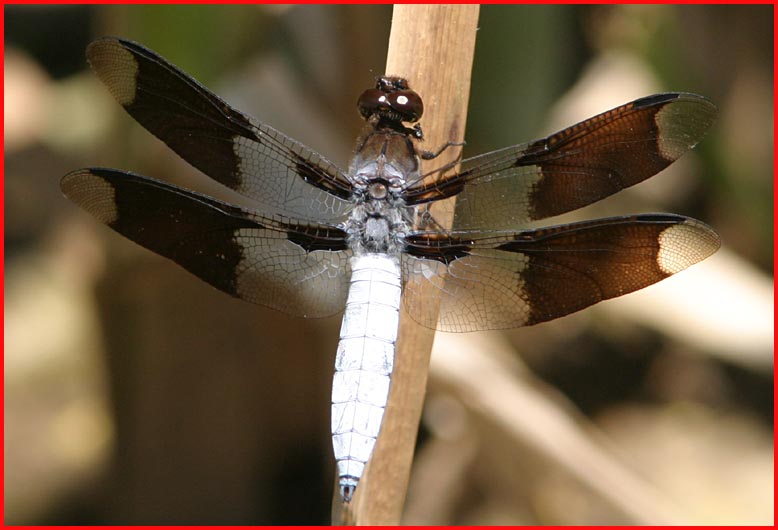
photos of males
(above) 19 June 2006 Hayfork,
Trinity Co., CA © D. Roberson
photos of female & young male
(below) 12 Aug 2006
American River Parkway, Sacramento © D. Roberson
|
Females (below) have differently patterned
wings and a brown body
with distinct white dashes on the sides of the abdomen [see Manolis
2003
for separation from other skimmers].
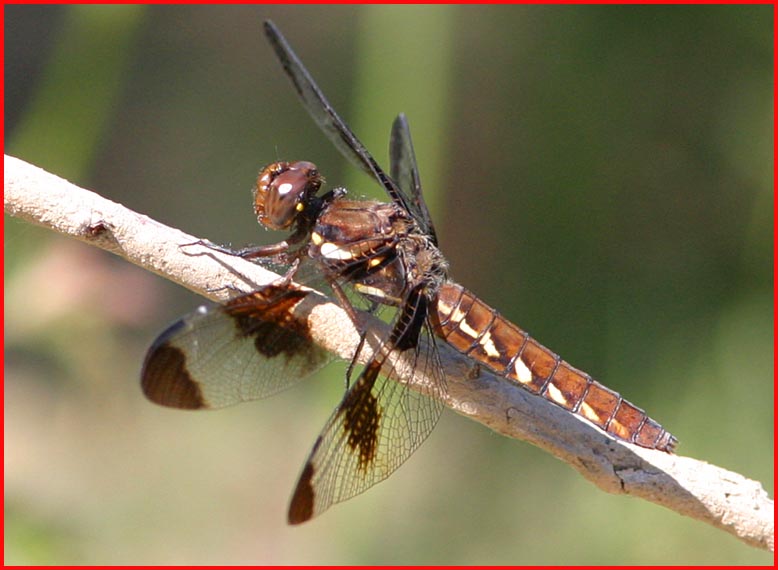
|
Immature males have female-like bodies but
male-patterned wings
(below).
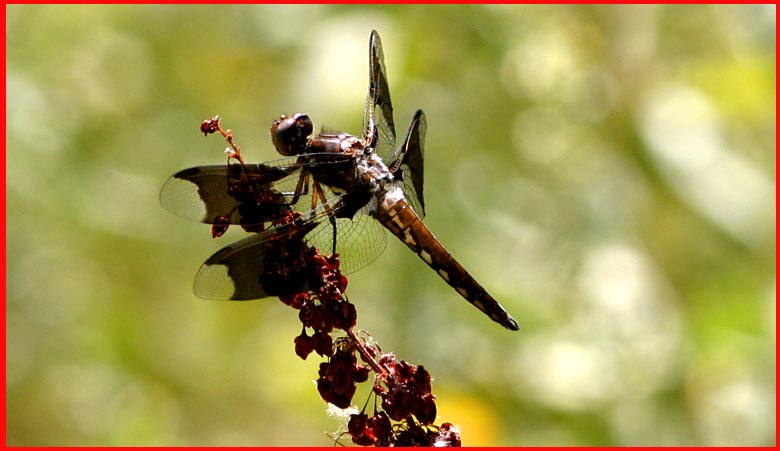
|
Many thanks to Walt Koenig, Paul Johnson, and Steve Rovell
for providing their photos, and for commenting on draft of this web
page. |
Literature cited:
- Koenig, W.D., and S.S. Albano. 1985. Patterns of
territoriality and mating
success in the White-tailed Skimmer Plathemis lydia (Odonata:
Anisoptera).
Amer. Midland Naturalist 114: 1-12.
- Koenig, W.D., and S.S. Albano. 1987a. Lifetime
reproductive success, selection,
and the opportunity for selection in the White-tailed Skimmer Plathemis
lydia (Odonata: Libellulidae). Evolution 41: 22-36.
- Koenig, W.D., and S.S. Albano. 1987b. Breeding site
fidelity in Plathemis
lydia (Drury) [Anisoptera: Libellulidae]. Odonatologica 16: 249-259.
- Koenig, W.D. 1990. Territory size and duration in the
White-tailed Skimmer
Plathemis
lydia (Odonata: Libellulidae). J. Animal Ecol. 59: 317-333.
- Manolis, T. 2003. Dragonflies and Damselflies of
California. Univ. of Calif.
Press, Berkeley.
Web resources:
Major identification web sites with much information on California
odes include:
For sites with excellent photos to compare for identification or to
simply
enjoy, see:
Many of these sites have links to other useful pages. Kathy Biggs's
site
is particularly useful in her selection of links. |
|
Photos © Don Roberson 2007 or
copyrighted to the photographer credited, and used with permission; all
rights reserved
TOP
|
|
|
Page created 2-3 Nov 2006
|
|
|
|
|



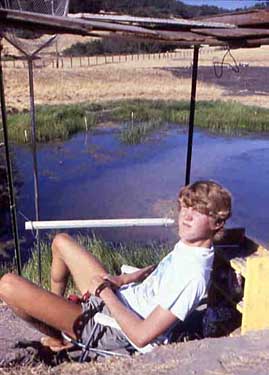
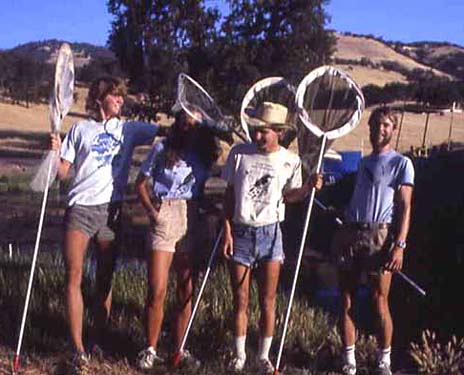
 In
all, Hastings researchers captured 691 Common Whitetails over 3
summers;
marked them with small colored dots (see photo, left), and released
them
to observe their behavior and ecology. It is fair to say that no one in
California knew Common Whitetail better than Walt Koenig and
colleagues.
In
all, Hastings researchers captured 691 Common Whitetails over 3
summers;
marked them with small colored dots (see photo, left), and released
them
to observe their behavior and ecology. It is fair to say that no one in
California knew Common Whitetail better than Walt Koenig and
colleagues.
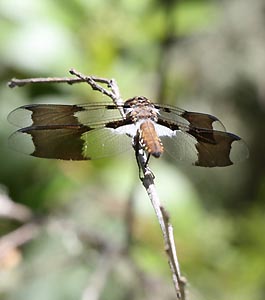
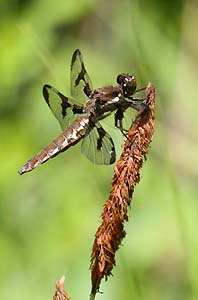
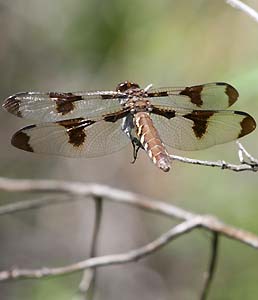
 Common
Whitetail is a widespread and familiar species across North America.
Its
absence from the MTY checklist until 2006, as described above, is just
an ironic oversight. The map (right) shows the locales at which it was
observed in 2006. It probably occurs at many interior lakes, tule-lined
ponds, and stock ponds.
Common
Whitetail is a widespread and familiar species across North America.
Its
absence from the MTY checklist until 2006, as described above, is just
an ironic oversight. The map (right) shows the locales at which it was
observed in 2006. It probably occurs at many interior lakes, tule-lined
ponds, and stock ponds.


